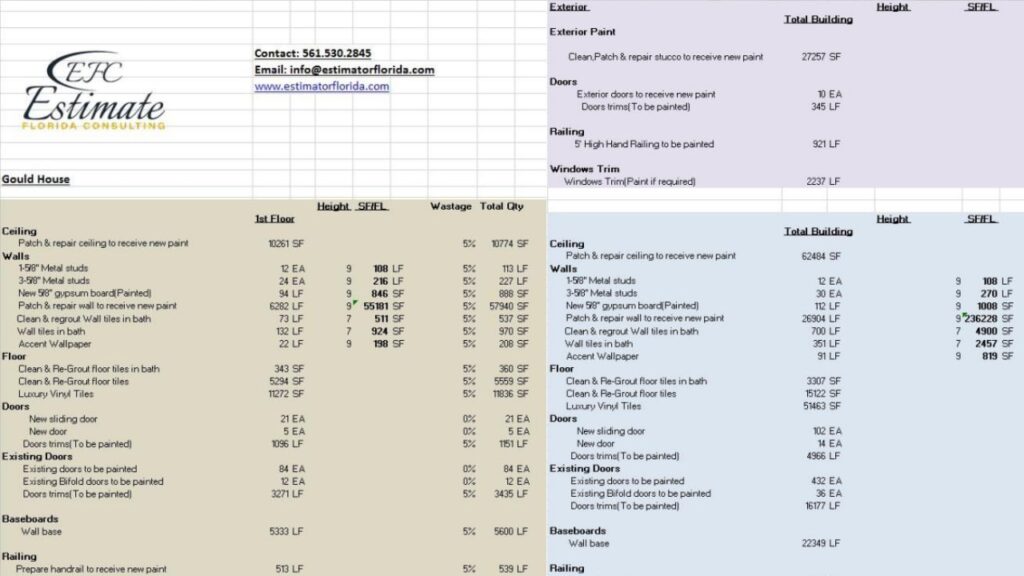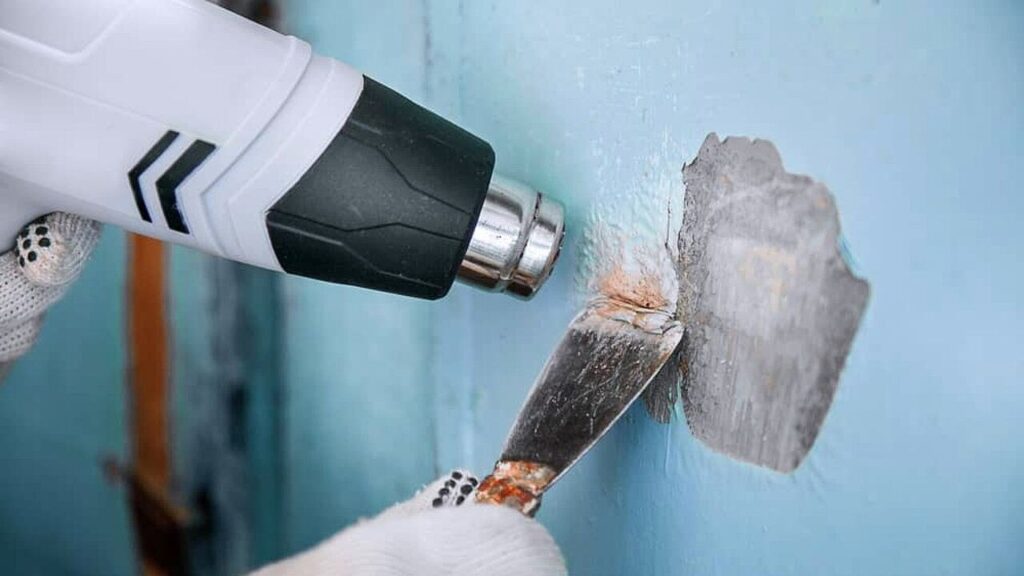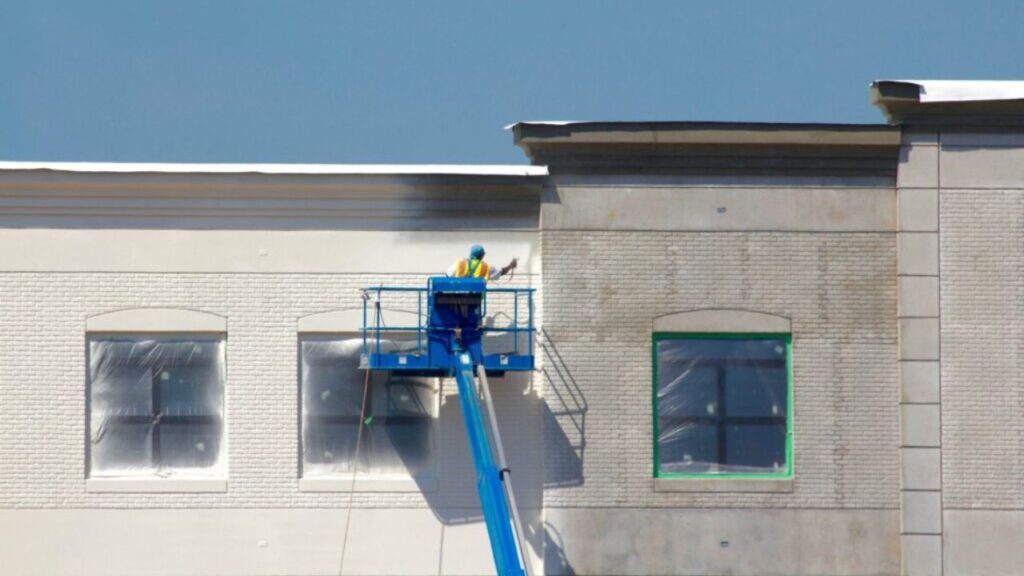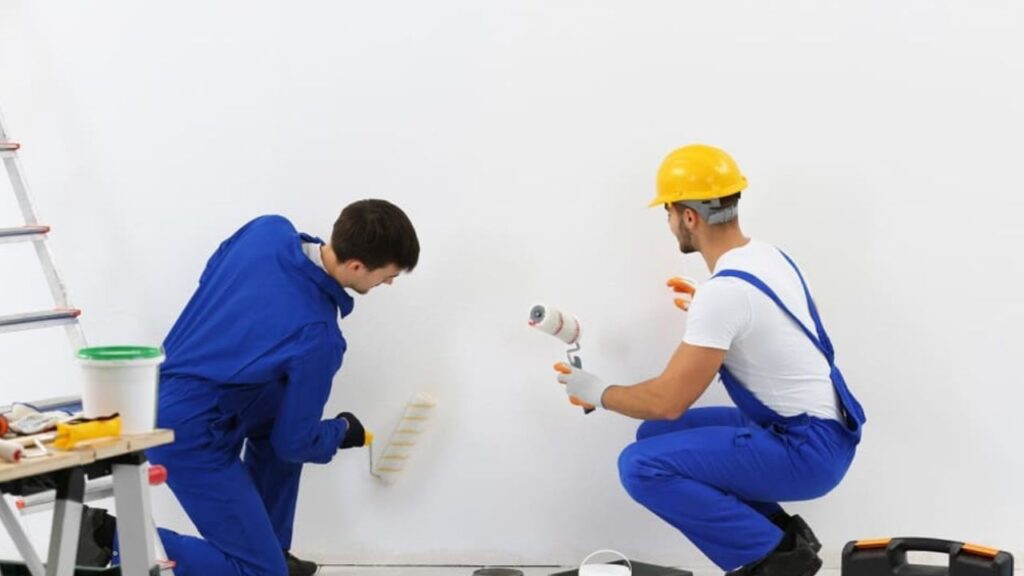A Wining Cost Estimate
That Helps You To Win More Painting Construction Projects

To calculate the cost of paint removal, you need to consider various factors that can affect the expenses. For estimating the cost of paint removal and surface preparation with respect to factors such as the type of surface to be worked on, type of paint or coating to be removed, size and area of the surface, and accessibility and location of the surface, we have two sub-sections. These sub-sections provide solutions to get you the most cost-effective approach to remove paint and prepare the surface for painting.
Different surfaces require various tools and techniques for successful cleaning. This depends on their durability, texture, porosity, and condition. Below is a table of common surface types and their estimated prep costs.
Surface Type | Estimated Cost |
|---|---|
Wood | $2 – $6/sq.ft. |
Brick/Concrete | $4 – $8/sq.ft. |
Metal | $5 – $10/sq.ft. |
Stucco | $3 – $7/sq.ft. |

Other factors such as the size of the project, accessibility, environment, and location can also influence paint removal and surface prep costs. It is important to consider the existing coatings on the surface. For instance, older paint which is lead based or hazardous may call for extra caution and increased expenses. A homeowner learned the hard way when they attempted a DIY wallpaper removal job in their living room. The wall ended up uneven with small holes. Hiring professionals would have been cheaper. So, it is always wise to include experts for complex home upgrades. Knowing these factors will help you plan financially before starting any painting or renovation project. Paint removal is like ending a clingy relationship – the type of paint matters.

The nature and type of coating to be removed are critical factors influencing paint removal cost. Different paints and coatings need different methods, materials, equipment, and skills, all of which impact the cost. For example, the table below compares the cost of various paint/coating removal techniques:
Type of Coating | Methodology | Cost (per sq. ft.) |
|---|---|---|
Latex | Abrasive Blasting | $0.50-$1.00 |
Chemical Stripping | $1.00-$2.50 | |
Power Washing | $0.20-$0.60 | |
Sanding | $0.50-$1.00 | |
Scraping | $0.40-$0.80 | |
Epoxy | Abrasive Blasting | $1.00-$3.00 |
Chemical Stripping | $4.00-$6.00 | |
Power Washing | $0.30-$1.00 | |
Sanding | $0.80-1-60 | |
Scraping | $5-7 per sqft |
Other factors impacting cost include the surface’s age and condition, its complexity or accessibility, location, environmental regulations, and additional services like patching or cleaning. Homeowners often get a high bill when removing multiple layers of lead-based paint from their old home’s interior walls before renovating it to meet modern safety standards. So, it’s important to consider all these things to accurately estimate removal costs and plan any painting or renovation work which needs paint removal first. Trying to remove paint from a small surface is like trying to squeeze a balloon animal back into its original form.
Surface area really matters for paint removal and prep. The bigger the area, the more time and effort needed. Location can also make a difference, as it may need special tools or access equipment.
A table demonstrates how size and area affect cost:
Size of Surface | Area in sq.ft. | Cost |
|---|---|---|
Small | 100-500 | $100 |
Medium | 501-1500 | $250 |
Large | 1501-3000 | $500 |
Extra Large | 3001+ | $750 |

Other factors that impact cost are the current paint job, surface type, and preparation detail.
Size was noted first in big painting projects, where contractors charged higher for larger tasks. Paint removal is simple, unless you need to reach a hard-to-reach spot!
Accessibility and location can really affect the cost of paint removal and surface preparation. This has to do with how easy it is for the painter to get to the area where the paint needs taking off.
See the table below for factors that can influence the cost in terms of accessibility and location:
Factors | Description |
|---|---|
Height | High surfaces take more time, tools and specialised skills, which ups the cost. |
Obstacles | Complicated surfaces take longer to prepare, like when there are pipes or electric cables blocking the painting area. |
Safety requirements | When painting high-rise buildings or hard-to-reach places, safety must be taken into account – this will add to the cost. |
When getting an estimate for painting a surface, all variables need to be looked at. That way, the painting company can give a proper quote that meets the customer’s needs.
It’s important to remember that accessibility is a major factor for economic development, from transport like roads and railways to water systems for irrigation. This highlights the need to address issues related to surface accessibility when repainting a surface. Removing paint is like getting rid of an ex – it takes time, effort, and a lot of hard work!

To ease your paint removal and surface preparation woes, this section provides solutions in the form of different techniques. Mechanical, chemical, thermal, and combination methods are briefly introduced as sub-sections. Explore each method to find the best technique suited for your specific surface.
Using physical force or tools to clean surfaces is known as ‘abrasive methods’. Different tools can be used, such as sandpaper, wire brushes, or blasting equipment.
The table below shows the pros and cons of each tool:
Tool | Pros | Cons |
|---|---|---|
Sandpaper | Low cost, easy to use | Time-consuming, can cause uneven marks on surface |
Wire Brushes | Good for removing rust, paint, and dirt | Can scratch the surface, may not reach tight spaces |
Blasting Equipment | Removes paint and dirt quickly, can reach tight spaces | Expensive, requires training to operate, can damage the surface if used improperly |
Moreover, abrasive methods are not suitable for all surfaces. Select tools that match the surface and take into consideration the hardness of the substrate. Mechanical methods can be used for paint removal and surface preparation. Safety precautions must be taken before any removal technique. Sandblasting can be used when regular sand doesn’t suffice.
Maximize your construction painting business’s potential with our competitive financing options

Abrasive Jet Machining, or sandblasting, is a surface preparation technique used to remove paint, rust, and other coatings. It is commonly used in the automotive, marine, and construction industries.
Table for Sandblasting:
Materials Used | Abrasive Particles |
|---|---|
Fine Sand | Silicon Carbide |
Aluminum Oxide | Glass Beads |
Walnut Shell Grit | Steel Grit |

Sandblasting can also be used to clean concrete surfaces and remove graffiti. But, be careful – it can damage delicate surfaces too!
Safety is key when using sandblasting. Wear protective gear, such as goggles and respirators. And, be sure to choose the right abrasives for the surface.
To get the best results, hire a professional, use high-quality equipment, and test before applying. Then, you can transition any surface from rough to smooth just like Monday mornings to Friday nights!
When it comes to paint removal and surface preparation, grinding and sanding are two of the most popular methods. Here’s what you need to know:
It’s important to remember that these techniques may not work for all materials. For example, some metals may require chemical stripping instead.
To get the best results with your surface preparation, make sure to research your project before getting started. Don’t forget to take the necessary safety precautions and use the right technique for the job.

Chemical techniques employ solvents and strippers to rid surfaces of paint. They are effective and can save time on large areas. The solvents break the paint down, making it simple to scrape or wash away.
Be mindful of safety guidelines. Some chemicals are hazardous and need protective wear. Test on an inconspicuous area before using on the entire surface. Don’t linger in fumes, and dispose of chemicals properly.
Chemicals have versatility, as they work on many surfaces—wood, metal, concrete. Different chemicals suit different surfaces, so research and choose for your project needs.
Eco-friendly alternatives exist to minimize environmental effects while still producing excellent results. Enjoy paint removal with solvents and strippers!
Solvent strippers
Solvent strippers are a rad way to remove paint from surfaces. Let’s look at the benefits and drawbacks.
Advantages:
Disadvantages:
Pick the right solvent for your project! Don’t forget safety precautions: wear gloves and eyewear, and make sure the workspace is properly ventilated.
Solvent stripping has been used for years in industry and for big projects like aircraft maintenance. Now, it’s available to DIYers for home projects. Try alkaline strippers – they’ll strip paint like a champ!
Alkaline Strippers, with a 2.0 pH, are great for quickly stripping paint and other coatings off surfaces like wood, metal and concrete. See the table below for the strength and versatility of different types.
Type | Strength | Surface Compatibility |
|---|---|---|
Caustic | High | Concrete, brick, stone |
Non-Caustic | Low | Wood, fiberglass |

But, using Alkaline Strippers doesn’t guarantee the surface is ready for recoating. Studies done by NCPTT show that if iron alloys aren’t neutralized after a 5% sodium hydroxide solution, corrosion rate increases.
So, to make sure future coatings aren’t damaged and the underlying surface is protected, it’s important to neutralize after stripping with alkaline solutions. Or, if you want paint to run for its life, try thermal methods.
Thermal methods are often used for removing paint and preparing surfaces. Heat Stripping uses hot air or infrared radiation, Flame Cleaning uses open flames to melt the coating, and Electric Heating applies electric current to soften the coating.
However, caution must be taken as thermal methods can damage some materials or substrates. Consideration and selection is key to avoiding surrounding structure damage.
Non-thermal techniques like chemical stripping may be preferred by professionals for reasons such as minimizing fire hazards and reducing toxic fumes.
A study showed that heat application was faster than chemical strippers for removing paint from steel. So, who needs a flamethrower when you can just use a heat gun? Just don’t get too carried away with it on Grandma’s antique dresser!

Heat guns
Heat Applications – An Effective Way to Strip Paint!
Using heat to remove paint can be very effective. Here’s what you should keep in mind when using a heat gun:
Ventilation is key to prevent dangerous fumes.
Also, this method may not work on surfaces made of plastic or materials close together.
The “Journal of Coatings Technology and Research” showed that heat application can remove coatings without damaging the substrate.
So forget the spotlight, get a heat gun and get rid of that paint!
Torches
Torches are an effective heat source for removing paint. They work by directing fire at the paint, making it expand and break apart. This makes it easier to scrape or brush away the residue.
Some things to remember when using Torches:
Torches can be an effective way of removing coatings from different surfaces. Precautions and techniques must be followed for safety and optimal results. For a true surface preparation masterpiece, why not combine all paint removal methods?
Combining various techniques can lead to effective methods for paint removal and surface preparation. Sandblasting with chemicals is one option; it involves blasting the surface and then using acid to soften any residue. Heat stripping and abrasive blasting can also be used to remove paint and surface oxidation. Power washing and chemical treatments are another option – this involves using water pressure and chemical treatments to clean.
Before beginning any form of paint removal, safety gear such as eyewear, gloves, respirators and overalls should be worn. Each step should be carefully assessed to ensure they are compatible with each other. By using these powerful methods, surfaces can be ready for refinishing processes like painting. Chemical or mechanical? Why not both? Let’s remove that paint like a boss!
Chemical/mechanical

Chemical and mechanical techniques can both be used for paint removal and surface preparation. Chemical solutions can dissolve the paint, while mechanical methods are physical abrasion or scraping. Check out this table:
Technique | Description |
|---|---|
Sandblasting | High-pressure blasting of sand or other abrasives |
Chemical | Solvents to dissolve paint |
Heat | Stripping paint with hot air or infrared radiation |
Power washing | High-pressure water spray to remove loose materials |
Grinding | Removal of surface layers with a grinding machine |
Certain techniques may only work on particular paints or surfaces. Also, some may generate hazardous dust or fumes. Thus, it’s necessary to choose the right technique for each situation and take safety precautions.
Pro Tip: Before painting over a stripped surface, clean and dry it properly to avoid residue that could affect adhesion.
Who needs a spa day when you can let the chemicals and heat do the exfoliating for you? #DIYpaintremoval

Chemical/thermal
Using heat or chemicals is a common method for surface prep and paint removal. It’s been shown to be effective in getting rid of tough paints and contaminants.
Here’s a look at the various methods and substances used:
Method/Substance | Description |
|---|---|
Chemical stripping | Solvents or chemical solutions dissolve the paint. This is mainly used indoors due to its toxic nature. |
Heat guns | Hot air softens the paint, which can then be scraped off. It can produce fumes, so it’s best for outside projects. |
Sandblasting | Pressurized sand particles take away paint coatings from metal surfaces. If not done right it can cause damage. |
Each has pros and cons based on the surface, environment, and safety.
To use these techniques you need proper ventilation and personal protective equipment (PPE). Not doing so could lead to exposure to hazardous chemicals and gases.
Read instructions and dispose of waste materials according to local regs. Be ready to pay for a clean surface!
To estimate the expenses involved in removing paint and preparing the surface, you need to consider several factors. With the section “Expenses involved in paint removal and surface preparation” of the article “Estimating the Cost of Paint Removal and Surface Preparation: Techniques and Expenses” and its sub-sections namely, labor costs, equipment and material costs, disposal costs, and additional expenses, you can get a clear insight into each cost element.
Expenses for the workforce involved in paint removal and surface preparation can vary. This depends on factors such as project size, surface complexity, and skill level. A small residential project might need one worker for a few hours. But big industrial projects require multiple workers with specialized skills, over long periods.
An example: a 1500 square feet residential house needs interior paint removal and surface preparation. Labor cost for two skilled workers is $500 to $800 a day, depending on experience. Location, equipment rentals, and worker training also affect labor costs. So, hiring experienced professionals with proper tools and training is key.

Take Jane, for instance. She needed old furniture stripped of paint, but found out professional help was needed. DIY enthusiasts don’t have professional-grade tools that can scrape off paint without damaging the material. This can save extra costs of replacing damaged items if help had been sought earlier.
When it comes to paint removal and surface prep, there’s a few things to account for, like equipment and materials. Here’s a table of the estimated costs for equipment and materials for paint removal and surface prep:
Equipment/Materials | Cost |
|---|---|
Paint Stripper | $20 |
Sandpaper (various grits) | $10 |
Heat Gun | $50 |
Chemical Cleaner | $15 |
Power Sander | $100 |
Remember, these are just estimates. The actual costs may differ depending on the amount of paint you need to remove and the type of surface you’re prepping. Plus, extra ventilation or safety gear could be needed for safety reasons. Labor costs may also come into play if you need professional help. So make sure to factor in all expenses when budgeting for this project. That way, you can guarantee a successful outcome!

Disposal of paint and other wastes can get pricey. It’s crucial to label, store, and dispose of any hazardous material according to local regulations. Landfill fees could apply depending on the amount of waste. And if it’s lead-based paint, extra regulations and costs may enter the picture.
Beware: Improper disposal can result in hefty fines and damage the environment. So take care when disposing of paint-related waste. Recycling and reuse can help cut costs. Plus, purchasing eco-friendly products helps reduce waste.
Plan ahead and be aware – that way, paint removal and disposal costs can be kept low, while the environment stays safe. Who knew getting rid of paint could be so pricey? It’s like trying to fix a problem with another problem!
Painting prep costs add up, causing an unanticipated bill for homeowners. Beyond the main painting supplies, there are more expenses to consider. Such as:
Also, be aware that budget-busting surprises might happen- like contractor changes, delays, or other unforeseen issues.
To avoid unexpected costs, make sure your budget plan covers all the essentials before you start the project. This way, you’ll have peace of mind knowing your home improvements won’t break the bank. Plus, don’t forget about the transportation costs for paint removal – they can be a real pain!
Transportation costs
Transportation expenses cover the cost of moving items to and from the job site. It varies, based on the amount of materials and the distance they need to go.
An example is a 5-gallon bucket of paint. It weighs around 50 pounds and needs to be transported over 20 miles.
This may involve multiple trips if more items are needed or mistakes were made.
HomeAdvisor says that these expenses can be up to 10% of the total cost.
So, don’t forget to include transportation when calculating paint removal and surface prep costs. Got it? Good! ‘Cause that paint won’t remove itself!
Permit fees
Mother Nature is like an expenses auditor – she always finds ways to charge you for your mess, even when it comes to paint removal. It’s essential to consider all costs involved, including permit fees, which can vary depending on the project type and location. Here’s what to keep in mind:

Remember, regulations can change. Check with local authorities for up-to-date info. It’s important to stay current, so you don’t get hit with hefty fines! Overall, understanding permit fees requires an appreciation of their history – regulations have developed over time to protect workers and ensure safety.
Environmental assessments
When considering the environment, paint removal and surface preparation processes are very important. Assessing the environmental impact is a must to meet regulations and industry standards. This assessment involves studying the area closely – from soil to air quality and water supplies – to decide what steps to take for a safe and eco-friendly surface prep.
It’s critical to take precautions to limit risks from hazardous materials, and make sure safety measures are in place before beginning. This could include using eco-friendly chemicals or alternative methods to reduce waste creation.
Hazardous waste made during paint removal and surface prep should also be disposed of properly to avoid contaminating groundwater or causing environmental damage. Plus, estimating the cost of paint removal will require some budgeting magic.
To estimate the cost of paint removal and surface preparation, you need to plan and budget ahead according to your needs and preferences. You can obtain quotes and bids from contractors, calculate the overall project cost, allocate funds for unforeseen expenses, and choose the most cost-effective method. These sub-sections will guide you in determining the cost of paint removal and surface preparation while meeting your budget.
When hiring contractors for paint removal and surface preparation, request quotes and bids. Consider these points:
Don’t forget: Requesting quotes and bids is only one step. Carefully review proposals and ask questions.

Missing out on qualified contractors can lead to costly mistakes and safety hazards. Do your research, request quotes, and make a well-informed decision. Calculating project cost is tricky – you’ll need to make educated guesses and hope for the best.
Calculating Total Expenses
To work out the final cost of a paint removal and surface prep project, it’s important to factor in all expenses. This includes direct costs such as labor and materials, and indirect costs like permits and project management.
Use this table to get an idea of potential cost items to include:
Cost Item | Description |
|---|---|
Labor Costs | Expense of hiring skilled personnel |
Materials Costs | Expense of getting necessary materials |
Equipment Rental | Expense of renting or buying equipment |
Waste Disposal | Expense of disposing waste |
Transport Costs | Total expense of transporting workers and materials |
Permits | Costs of getting relevant permits |
Project Management | Expense of managing stakeholders |
Include contingency funds for unexpected costs during the project.
Projects vary in cost, depending on size, location, time frame, coating system, surface conditions, and accessibility. Think about these factors when budgeting.
Keep records of estimated and actual costs throughout the project. Review and adjust regularly.

Cost estimation and budgeting involves foreseeing expenses for a project. However, there may be unanticipated costs that can affect the budget. Here are tips to consider when budgeting for these:
Keep in mind, even with thorough planning and estimating, unexpected costs might occur. To lessen the impact on the project, it is best to have an understanding of possible risks and to form contingency plans in advance.
When budgeting for unforeseen costs, careful consideration and planning is necessary. Ensure to assess your budget against actual costs often and make changes accordingly. This helps to guarantee that unexpected costs are accounted for without profoundly influencing the final cost estimation.
I had a project once where we thought of all feasible costs but encountered a sudden issue that was out of our control — soil contamination at the site. The cleanup cost was much more than what we estimated and threw off our whole budget. It was a great lesson in the significance of having contingency plans prepared for unforeseen issues.
If you’re aiming to save money on paint removal, remember: sometimes the cheapest option turns out to be the most expensive mistake.
When evaluating cost-effective solutions, it’s important to explore every option. Here’s a breakdown:
Option | Process | Cost Estimate |
Hand Sanding | Manual sandpaper and elbow grease | $1-$2 per square foot |
Blasting | Sand, water, or media blasting with machines | $2-$4 per square foot |
Chemical Stripping | Spray chemical paint removers and let sit for a specific time frame | $3-$6 per square foot |
Safety, liability, and equipment damage are also worth considering. For cost savings, go with hand sanding if you have the manpower. But if speed is more important, chemical stripping is your best bet. Make sure to do it right the first time – no paint chips later!
Paint removal and surface preparation are important aspects of any construction or renovation project. Sandblasting or chemical paint stripper for paint removal, and moisture blasting or power washing for surface prep, should be considered.
Costs, manpower, environment rules and safety measures must all be taken into account. Thoroughly inspect the surface before deciding on a technique, to customize and save money.
Good paint removal and surface prep can add years to coatings and cut down on maintenance costs. Make sure to prioritize these tasks early on in the project plan, and stay up to date with industry developments to control costs without sacrificing quality.
There are various techniques that can be used to estimate the cost of paint removal and surface preparation, including visual inspection, measurement of surface area, and consideration of the type of paint to be removed and the equipment needed for the job.
The cost of paint removal and surface preparation can vary depending on several factors. On average, the cost is typically between $2 and $6 per square foot.
Equipment required for paint removal and surface preparation include sanders, grinders, scrapers, pressure washers, and chemical strippers, among others.
The timeframe needed for paint removal and surface preparation will depend on the size of the project, the complexity of the job, and the equipment used. A typical project can take anywhere from a few days to a few weeks to complete.
While it is possible to do paint removal and surface preparation as a DIY project, it is often recommended to hire a professional to ensure the job is done correctly and safely.
Yes, paint removal and surface preparation can be done in cold weather. However, the temperature may affect the performance of certain chemicals and equipment.
Here I am going to share some steps to get your painting construction cost estimate report.
You can send us your plan on info@estimatorflorida.com
Before starting your project, we send you a quote for your service. That quote will have detailed information about your project. Here you will get information about the size, difficulty, complexity and bid date when determining pricing.
We do painting construction cost estimating and prepare a detailed report for your project. At last, you finalize the report and finish the project.
561-530-2845
info@estimatorflorida.com
Address
5245 Wiles Rd Apt 3-102 St. Pete Beach, FL 33073 United States
561-530-2845
info@estimatorflorida.com
Address
5245 Wiles Rd Apt 3-102 St. Pete Beach, FL 33073 United States
All copyright © Reserved | Designed By V Marketing Media | Disclaimer
IMPORTANT: Make sure the email and cell phone number you enter are correct. We will email and text you a link to get started.
By clicking “I Agree” above you give Estimate Florida Consultin express written consent to deliver or cause to be delivered calls and messages to you by email, telephone, pre-recorded message, autodialer, and text. Message and data rates may apply. You are able to opt-out at any time. You can text STOP to cancel future text messages.